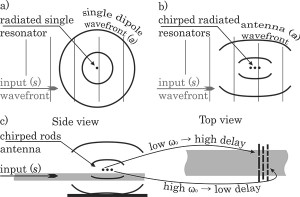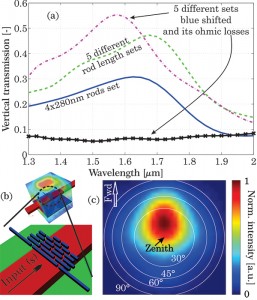Frequency-chirped Sub-wavelength Nanoantennas
- Category: Optics & Photonics
- Tags: ami yaacobi, michael watts
Vertical coupling can be used in silicon on insulator-based optical phased arrays (OPA) to emit light traveling in a waveguide to a free space mode. Vertical input/output coupling has been extensively investigated for coupling to or from optical fibers e.g.[1][2][3]; thus coupler size generally equals the diameter of a fiber mode (~10 µm or more). This large side (>>the wavelength) inherently cause the coupler to be narrow banded (< 60 nm band width). Moreover, in an OPA, a small footprint is desired in an emitter (ideally <1 wavelength), as it is critical to fitting many emitters in a small area. Short emitters have been demonstrated using nanoantenna designs translated from the radio frequency (RF) to optical bands[4][5][6]. However, RF antennas can be fed from thin transmission lines, enabling excitation of the antenna to occur from a single location. In a photonic nanoantenna, the open dielectric waveguide precludes separation of the guided wave from the antenna structure, so the guided wave interacts with the entire antenna. This difference requires a new approach to enable compact, efficient emission from such antennas.
Our work[7] proposes a new nanoantenna structure that uses resonance-chirped components to create a short, broadband vertical coupler (Figure 1). The coupler couples light from a Si photonic waveguide to free space and consists of Al nanorods above a Si3N4 waveguide, and a metal ground plane to reflect up downward radiation. We simulated this antenna in the telecom C-band using finite-difference time-domain techniques. We predict 55% peak efficiency and ~ 500 nm of bandwidth (Figure 2) in a structure only λ/3 long. Using different metal and dielectric materials would allow this coupler to work from the optical band to RF. To our knowledge this structure is the first proposed and numerically verified compact (<1 wavelength) emitter design of its kind.
- Figure 1. (a) Side view of single resonator (here a dipole) driven by plane wavefront, (b) Set of chirped resonators design for right-angle wave coupling driven with same source as (a), (c) Side and top views of set of resonators designed for vertical coupling from waveguide to free space. Total structure length is <1>
- Figure 2. (a) Simulated vertical emission for different structures, (b) Final structure with time integrated field box showing radiated field, (c) Free space far field pattern of same structure at λ=1550 nm.
- G. Roelkens, D. Vermeulen, S. Selvaraja, R. Halir, W. Bogaerts and D. V. Thourhout, “Grating-Based Optical Fiber Interfaces for Silicon-on-Insulator Photonic Integrated Circuits,” IEEE Journal of Selected Topics in Quantum Electronics, vol. 17, no. 3, pp. 571-580, (2011). [↩]
- M. Fan, M. A. Popović, and F. X. Kärtner, “High Directivity, Vertical Fiber-to-Chip Coupler with Anisotropically Radiating Grating Teeth,” in OSA/CLEO CTuDD3 (2007). [↩]
- G. Roelkens, D. V. Thourhout and R. Baets, “High efficiency grating coupler between silicon-on-insulator waveguides and perfectly vertical optical fibers,” Optics Letters vol. 32, pp. 1495-1497, (2007). [↩]
- A. Yaacobi, E. Timurdogan, and M. Watts, “Vertical emitting aperture nanoantennas,” Optics Letters vol. 37, pp. 1454-1456 (2012). [↩]
- T. Kosako, Y. Kadoya, H. F. Hofmann, “Directional control of light by a nano-optical Yagi-Uda antenna,” Nature Photonics, vol. 4, no. 5, pp. 312-315 (2010). [↩]
- J. Li and N. Engheta, “Core-shell nanowire optical antennas fed by slab waveguides” IEEE Transactions on Antennas and Propagation, Vol. 55, No. 11, Nov. 2007 [↩]
- A. Yaacobi and M. Watts, “Frequency-chirped sub-wavelength nanoantennas,” Optics Letters, vol. 37, pp. 4979-4981 (2012). [↩]

